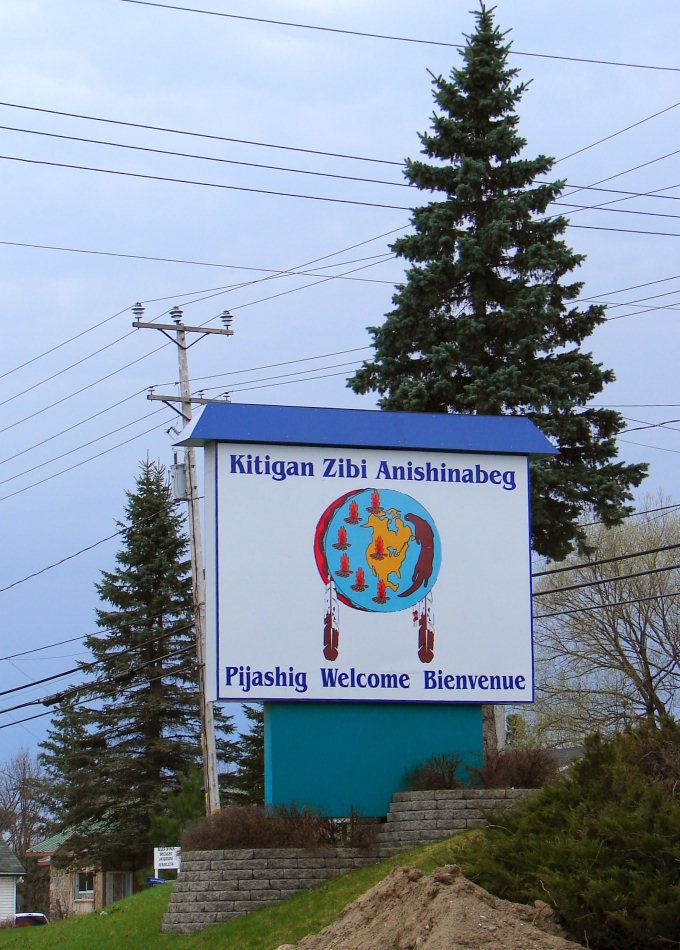Established 1851 Postal Code J9E Area 183.9 km² Province Québec | Region Outaouais Time zone EST (UTC-5) Website www.kza.qc.ca Local time Wednesday 6:55 PM Area code 819 | |
 | ||
Weather -6°C, Wind NW at 18 km/h, 70% Humidity | ||
Ottawa xyz pinock kitigan zibi anishinabeg
Kitigan Zibi (also known as River Desert, and designated as Maniwaki 18 until 1994) is a First Nations reserve of the Kitigan Zibi Anishinabeg First Nation, an Algonquin band. It is situated at the confluence of the Désert and Gatineau Rivers, and borders south-west on the Town of Maniwaki in the Outaouais region of Quebec, Canada. Having a total area of 183.9 square kilometres (71.0 sq mi), it is the largest Algonquin Nation in Canada, in both area and population.
Contents
- Ottawa xyz pinock kitigan zibi anishinabeg
- Map of Kitigan Zibi QC Canada
- Kitigan zibi anishinabeg 2015
- Toponymy
- Geography
- History
- Demographics
- Language
- List of chiefs
- Culture and tourism
- References
Map of Kitigan Zibi, QC, Canada
Present in the reserve are grocery and hardware supermarkets, gas station, elementary and secondary schools with a library accessible to the whole community, gift shops, a community radio station, a day-care, a community hall, a health centre, a police department, a youth centre, a wildlife centre, and an educational and cultural centre.
Kitigan zibi anishinabeg 2015
Toponymy
Kitigàn means "garden" or "cultivated land." Since Algonquins were historically not farmers, it may be that, in this case, this name originated as a reference to a clearing made by the Hudson's Bay Company for the establishment of its post, dependencies, and the adjoining garden.
Geography
The reserve is bounded by the Eagle River along its west side, by the Desert River on the north side, and the Gatineau River on the east side. Most of its development is along or near Highway 105, while forest still covers much of the reserve.
It is also home to 13 fresh water lakes with areas in excess of 250,000 square metres (2,700,000 sq ft) or 25 hectares (62 acres) and approximately 29 smaller lakes and streams located throughout the territory.
Fish species found within these waters are walleye, pike, bass, trout, carp, catfish, and fresh water sturgeon. Mammals found within the reserve include beaver, muskrat, fisher, martin, mink, otter, bobcat, lynx, cougar, deer, black bear, wolf, and moose.
History
The history of the reserve is closely linked to that of the Town of Maniwaki, which developed concurrently.
In the first half of the nineteenth century, Algonquins of the mission at Lake of Two Mountains, under the leadership of Chief Pakinawatik, came to the area of the Désert River. Shortly after in 1832, the Hudson's Bay Company followed them and installed a trading post at the mouth of this river (now within the municipal boundaries of Maniwaki). A decade later, Missionary Oblates of Mary Immaculate established the mission of Notre-Dame-du-Desert and, from 1849, they demanded of the authorities the demarcation of a township in order to establish a reserve for the Algonquins. Chief Pakinawatik, along with other leaders, journeyed by canoe on three separate occasions to Upper Canada (Toronto) and negotiated the terms for the setting aside of the reserve land. The township limits were drawn in 1850 and given the name of Maniwaki by the Oblates at this time. In Algonquin language, the place was identified as Kitigànsìpì or Kitigàn Zìbì, meaning "Garden River."
Legally established in 1851, the reserve was demarcated in 1853. In the decree implementing it, the reserve was called "Manawaki" and also "River Desert". The name "Kitigan Zibi" came to replace the other two on September 24, 1994, when the band council gave this title to the reserve.
Because of land claim settlements in the late 1990s, small portions of land of the Town of Maniwaki were added to Kitigan Zibi.
Concerned about the disinterest of its youth in their own language, the community has decided to reintroduce the teaching of the Algonquin language in school.
Demographics
As of September 2012, the registered population of the Kitigan Zibi Anishinabeg First Nation is 2,988 members, of whom 1,560 live on the Kitigan Zibi reserve, 28 live on another reserve or crown land, and 1400 live off reserve.
Canada Census data before 2001:
Language
Languages:
List of chiefs
Culture and tourism
The Kitigan Zibi Pow Wow is held annually, on the first weekend of June. The Kitigan Zibi Cultural Centre has a number of exhibits, cultural artifacts, paintings, and photographs relating to the Algonquin culture and history. A living museum, Mawandoseg Kitigan Zibi, is dedicated to traditional Anishinaabeg way of life.
